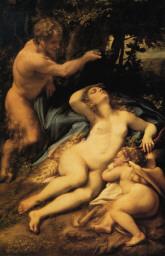A major show on Renaissance great Antonio Allegri da Correggio (1489-1534) opening on Saturday will draw thousands of visitors to his adopted city of Parma, Mayor Pietro Vignali said.
The exhibit at the Parma National Gallery is the second major event this year devoted to the artist and already looks set to be a hit, with 30,000 advance bookings.
It showcases some 200 works on loan from Italian and foreign collections and encompasses Correggio's three most important frescos in situ, offering visitors a chance to grasp his importance.
''Correggio was a giant artist who refused to act like a prima donna'', said curator Lucia Fornari Schianchi.
Despite achieving widespread recognition in his own day, Correggio's work was often overlooked in favour of his contemporaries by later generations.
Critics say this neglect has little to do with his skill and much to do with the fact he never worked in Rome - a de rigueur rite of passage for artists that gave them the chance to rub shoulders with rich patrons and contribute to masterpieces at major sites.
The event in Parma, which comes immediately after a major show at Rome's Galleria Borghese, will give visitors the unique opportunity to admire his frescos up close and in detail, thanks to a system of lifts and scaffolding set up for the duration of the exhibit.
The Convent of St Paul houses a fresco featuring an arbour and cherubs, which decorated the ceiling of what was once the dining room of the Mother Superior.
Completed in 1519, this was followed the next year by a scene of St. John on Patmos for the dome of the Church of San Giovanni Evangelista.
The third work is a 1524 fresco on the dome of the Cathedral of Parma, showing a dramatic, layered scene of the Assumption of the Virgin.
The latter two works in particular are considered emblematic of Correggio's skill with illusion and perspective, which influenced the work of dozens of future fresco artists.
The artist spent most of his adult life in Parma, and the vast majority of his works, particularly his frescoes, are now located in either Parma, Modena or Correggio, the small town where he was born not far from Reggio Emilia.
However, Correggio's name has enjoyed a resurgence of interest in recent years and he is now considered one of the most skilled, innovative and lively 16th-century artists, drawing particular praise for his use of illusionistic perspective and foreshortening.
The Parma show includes around 40 pieces by his contemporaries, helping provide context.
The selection includes a number of his paintings inspired by the myths and patterns of Ancient Rome, as well as focusing on more conventional religious subjects.
The exhibit in Parma's National Gallery, entitled simply ''Correggio'', runs from September 20 until January 25.


